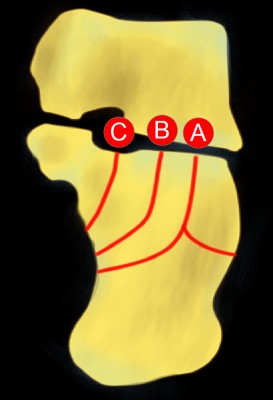Fracture of calcaneus - Sanders CT classification of intra-articular fractures
The Sanders classification is based on CT evaluation of calcaneus in coronal plane. The classification was published in 1992 and it takes into account location and number of fracture lines. The image is evaluated in coronal plane where it shows the posterior articular facet in its widest (latero-lateral) profile, where the location of primary fracture line with relation to the posterior articular facet is determined (intra-articular fracture).
| Type | Description |
|---|---|
| Type I | undisplaced articular fractures (<2mm) of the posterior facet irrespective of the number of fracture lines |
| Type II | two-part fracture of the posterior facet (one fracture line) IIA: primary fracture line is lateral IIB: primary fracture line is central IIC: primary fracture line is medial |
| Type III | three-part fracture of the posterior facet with a centrally depressed fragment (two fracture lines) IIIAB: primary fracture lines lateral and central IIIAC: primary fracture lines lateral and medial IIIBC: primary fracture lines central and medial |
| Type IV | more than three-part highly comminuted articular fractures of the posterior facet (≥ three fracture lines) |
References:
1. Furey A, Stone C, Squire D, Harnett J. Os calcis fractures: analysis of interobserver variability in using Sanders classification. J Foot Ankle Surg. 2003 Feb;42(1):21–3.
2. Bhattacharya R, Vassan UT, Finn P, Port A. Sanders classification of fractures of the os calcis AN ANALYSIS OF INTER- AND INTRA-OBSERVER VARIABILITY. J Bone Joint Surg Br. 2005 Feb 1;87-B(2):205–8.
3. Sanders R. Intra-articular fractures of the calcaneus: present state of the art. J Orthop Trauma. 1992;6(2):252–65.
4. Badillo K, Pacheco JA, Padua SO, Gomez AA, Colon E, Vidal JA. Multidetector CT Evaluation of Calcaneal Fractures. Radiographics. 2011 Jan 1;31(1):81–92.
Images:

